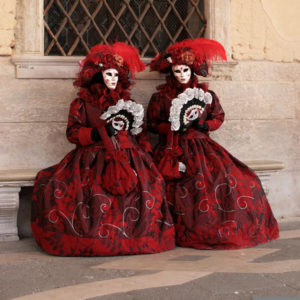This past weekend marked the beginning of the Carnival Season in Venice. Carnevale, as it is called there, is a time of masks and intrigue and high Baroque fashion. This year it is a bit later than usual; Carnevale is a moveable celebration based on the timing of Lent, which is based on the timing of Easter… all of which is based on lunar events, even within our solar-based calendar. And so Lent, which typically begins in February, won’t begin this year until March 6th, making March 5th Shrove Tuesday, or Mardi Gras: the conclusion and height of Carnevale.
Carnevale in Italy has its connections to celebrations of the new year, which, for the early Romans, was the First of March. The costumes and the masks come out of this tradition, for they were part of the Roman New Year celebration. The old year was dying, the new one being born. Out of that chaos came a festival of excess, and masks provided anonymity. The Romans eventually moved the start of the year to January 1, but old habits die hard: The costumes and the masks then and now give us license to be whomever we wish, at least for a little while. And the costumes and masks of Venice are, I think, the most beautiful of all Carnival finery.
It is a time of clearing out the larder, for Lent will bring sacred restrictions on food. Nowadays, of course, the restrictions of Lent are pretty easy: the only hard and fast rule is no meat on Fridays. In times past, though, Lent was indeed a time of serious fasting: no meat, no eggs, no fun, no nothing. The provisions had to be used up before Lent and so that, too, was part of Carnevale’s excess. The Carnival Season became a time of feasting to use up all the sausages, all the eggs, all the things that would be banned for the somber forty days to come. But the fast was as much a common sense strategy as a religious ceremony: by late winter, provisions that were stored up were beginning to dwindle; a time of restriction and fasting helped insure the populace would make it through to spring, when fresh food would once again be available.
The elaborate costumes of a Venetian Carnevale go hand in hand with the traditional symbol of Carnevale in Italy, which is a plump man wearing a necklace of sausages about his neck. The Baroque costumes and the plump man ringed with sausages are both in stark contrast to the traditional symbol of Lent: a gaunt old woman, all skin and bones. She’ll come soon enough. For now, we celebrate. Traditional festive foods for Carnevale vary throughout Italy, but many, especially the sweets, are fried. It is even thought that the ever popular Cannoli, the Italian dessert known around the world, originated as a Carnevale treat from Sicily. A simpler Carnevale recipe to try, and a favorite throughout Italy at this time of year, is Chiacciere. They take their name from the Italian for gossip, or small talk, but we’re talking here not about gossip but about strips of lemon-scented dough, fried crisp and dusted with confectioners’ sugar. You’ll find many recipes online for Chiacciere through a web search. My sister is making some next week; we’ll be enjoying them, and if you are, too, let us know!
Image: Venice Carnival 2011, photograph by Petra Abendroth. Used with gratitude through Creative Commons via Wikimedia Commons.
